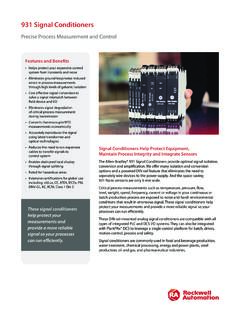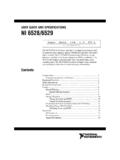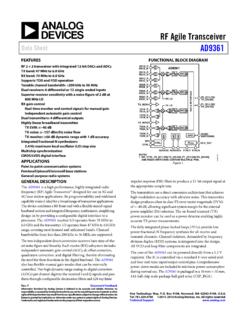Transcription of PC817 Series High Density Mounting Type Photocoupler
1 PC817 SeriesPC817 SeriesHigh Density Mounting TypePhotocouplernFeatures1. Current transfer ratio2. High isolation voltage between input and3. Compact dual-in-line packagenApplications1. Computer terminals2. System appliances, measuring instruments3. Registers, copiers, automatic vending4. Electric home appliances, such as fan output (Viso machines heaters, Dimensions (Unit : mm) data books, etc. Contact SHARP in order to obtain the latest version of the device specification sheets before using any SHARP's device. In the absence of confirmation by device specification sheets, SHARP takes no responsibility for any defects that occur in equipment using any of SHARP's devices, shown in catalogs,4.)
2 Recognized by UL, file No. E64380 PC847diagramInternal connectionPC817 Anode markPC817PC817PC817PC817PC817 Anode markPC817 Internal connectiondiagramPC837PC827PC817PC817PC8 17PC817 12431234 1 Anode2 Cathode3 Emitter4 Collector =0 to 13 1234567812 3456781 3 Anode2 4 Cathode5 7 Emitter6 8 CollectorAnodemark = 0 to 13 12 34 56789191357 Anode2468 Cathode =0 to 13 12 34 5678912 34 56789135 Anode246 Cathode7 9 Emitter8 Collector =0 to 13 9 Emitter CollectorInternal connection diagramInternal connection diagram PC817 : 1-channel type PC827: 2-channel type PC837: 3-channel type PC847: 4-channel type5.
3 Signal transmission between circuits of different potentials and impedancesAnode markhhTUV (VDE0884) approved type is also available as an option. (CTR: MIN. 50% at IF= 5mA,VCE=5V)CTRrank markh Lead forming type (I type) and taping reel type (P type) are also available. (PC817I/PC817P) : 5 000 Vrms) 567810101010*1 Pulse width <=100 s, Duty ratio : *3 For 10 secondsParameterSymbolRatingUnitInputFor ward currentIF50mA*1 Peak forward currentIFM1 AReverse voltageVR6 VPower dissipationP70mWOutputCollector-emitter voltageVCEO35 VEmitter-collector voltageVECO6 VCollector currentIC50mACollector power dissipationPC150mWTotal power dissipationPtot200mW*2 isolation voltageVisoOperating temperatureTopr- 30 to + 100 CStorage temperatureTstg- 55 to + 125 C*3 Soldering temperatureTsol260 C*4 Classification table of current transfer ratio is shown SeriesnAbsolute Maximum RatingsnElectro-optical CharacteristicsModel (%)
4 PC817 APC817 BPC817 CPC817 DRank markABCDA or BB or CC or DA, B or CB, C or DA, B, C or D80 to 160130 to 260200 to 400300 to 60080 to 260130 to 400200 to 60080 to 400130 to 60080 to 60050 to 600A, B, C, D or No mark0-253002550751001254050602010 Fig. 1 Forward Current vs. Ambient TemperatureAmbient temperature Ta ( C)(Ta = 25 C)(Ta = 25 C)Forward current IF (mA)5 000*2 40 to 60% RH, AC for 1 voltageVFIF= forward voltageVFMIFM= currentIRVR=4V--10 ATerminal capacitanceCtV = 0, f = 1kHz-30250pFOutputCollector dark currentICEOVCE= 20V--10-7 ATransfercharac-teristics*4 Current transfer ratioCTRIF= 5mA, VCE= 5V50-600%Collector-emitter saturation voltageVCE(sat)
5 IF= 20mA, IC= resistanceRISODC500V, 40 to 60% RH5 x 10101011- Floating capacitanceCfV = 0, f = frequencyfcVCE= 5V, IC= 2mA, RL= 100 , - 3dB-80-kHzResponse timeRise timetrVCE= 2V, IC= 2mA, RL= 100 -418 s-318 sFall timetfVrmsPC8h7 ABPC8h7 BCPC8h7 CDPC8h7 ACPC8h7 BDPC8h7 ADPC8h7h : 1 or 2 or 3 or 4 Duty ratio55 Pulse width <=100 s102010050200500210-310-25210-1525 Fig. 3 Peak Forward Current vs. Duty Ratio01 Current transfer ratio CTR (%)2002510205016012080402060100140180100 0501500 255075100 Relative current transfer ratio (%)Fig. 7 Relative Current Transfer Ratio vs. Ambient Temperature005110152025302345678920mA10m A5mAFig.
6 6 Collector Current vs. Collector-emitter VoltagePeak forward current IFM (mA)Fig. 4 Current Transfer Ratio vs. Forward CurrentForward current IF (mA)Collector current IC (mA)Collector-emitter voltage VCE (V)Ambient temperature Ta ( C)0012510020050150255075100 Ambient TemperatureC (mW)-30 Fig. 2 Collector Power Dissipation Seriesa ( C)Collector power dissipation PAmbient temperature T1 VCE=5 VIF= 30mA PC(MAX.)IF= 5mAVCE=5 VFig. 5 Forward Current vs. Forward Voltage10 0005 0002 0001 000Ta= 25 CTa= 25 C50 C25 C0 25 CTa= 75 CForward current IF (mA)Forward voltage VF (V)-30Ta= 25 8 Collector-emitter Saturation Voltage vs.
7 Ambient Temperature2505075100 Collector dark current ICEO(A) Frequency ResponseFrequency f (kHz) 100 Fig. 9 Collector Dark Current (sat)(V) Ambient TemperatureVoltage gain Av(dB) time ( s) (k )Collector-emitter saturation voltage VCE(sat)(V)Forward current IF(mA) Collector-emitter Saturation Voltage vs. Forward CurrentPC817 SeriesTest Circuit for Response TimeVCCttrts90%10%tdOutputInputRLInputOu tputRDVCCRLO utputRDTest Circuit for Frepuency ResponseCollector-emitter saturation voltage VAmbient temperature Ta( C)fIF= 20mAIC= 1mA10-1110-1010-910-810-710-610-5-25 VCE= 20 VAmbient temperature Ta( C)trtftstdVCE=2 VIC= 2mATa = 25 CRL= 10k VCE=2V1mA3mA5mATa= 25 CIC= 2mAIC= 25 CPlease refer to the chapter Precautions for Use Response Time vs.
8 Load ResistanceLoad resistance Rl









